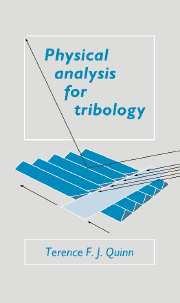Book contents
- Frontmatter
- Contents
- Preface
- Nomenclature list
- 1 Tribology
- 2 Macroscopic physical techniques
- 3 Microscopic physical techniques for studying atomic arrangement
- 4 Microscopic techniques for studying atomic structure
- 5 The analysis of lubricant films
- 6 The analysis of surface temperatures in tribo-systems
- 7 The analysis of pitting failures in tribo-systems
- 8 The analysis of oxidational wear in tribo-systems
- 9 The application of physical techniques to selected ceramic tribo-systems
- References
- Index
7 - The analysis of pitting failures in tribo-systems
Published online by Cambridge University Press: 29 October 2009
- Frontmatter
- Contents
- Preface
- Nomenclature list
- 1 Tribology
- 2 Macroscopic physical techniques
- 3 Microscopic physical techniques for studying atomic arrangement
- 4 Microscopic techniques for studying atomic structure
- 5 The analysis of lubricant films
- 6 The analysis of surface temperatures in tribo-systems
- 7 The analysis of pitting failures in tribo-systems
- 8 The analysis of oxidational wear in tribo-systems
- 9 The application of physical techniques to selected ceramic tribo-systems
- References
- Index
Summary
Failure in rolling contact bearings in nominal point contact
Introduction
Czichos (1980) defines a tribo-system as one in which motion, energy and materials are transmitted, in various relative amounts, according to the required function of the system, from clearly prescribed inputs to desired outputs. Invariably, motion is a characteristic of any tribo-system. Sometimes the purpose of the system may be to change the rate of motion or to eliminate it altogether (e.g. in brakes). Such changes involve undesired outputs, such as frictional heating and the undesired removal of material from the surface through which the motion is transmitted. Gears are intended to transfer motion and power in rotating machinery, but sometimes unwanted transfer of material may also occur. The wheels of a railway engine are intended to transmit force to the rail and hence produce motion, but again we find that the unwanted transfer of material, and the loss of energy due to slip, will make the actual output somewhat different from that which was desired. Cams and tappets, valves and valve seats, piston-cylinder systems, hot and cold rolling mills, sheet-forming and wire-drawing dies, metal cutting tools, dry bearings and current collectors are further examples of tribosystems which involve some degree of transfer of motion, energy and materials. All such tribo-systems are said to have failed when the actual output deviates significantly from the intended output.
- Type
- Chapter
- Information
- Physical Analysis for Tribology , pp. 360 - 398Publisher: Cambridge University PressPrint publication year: 1991



